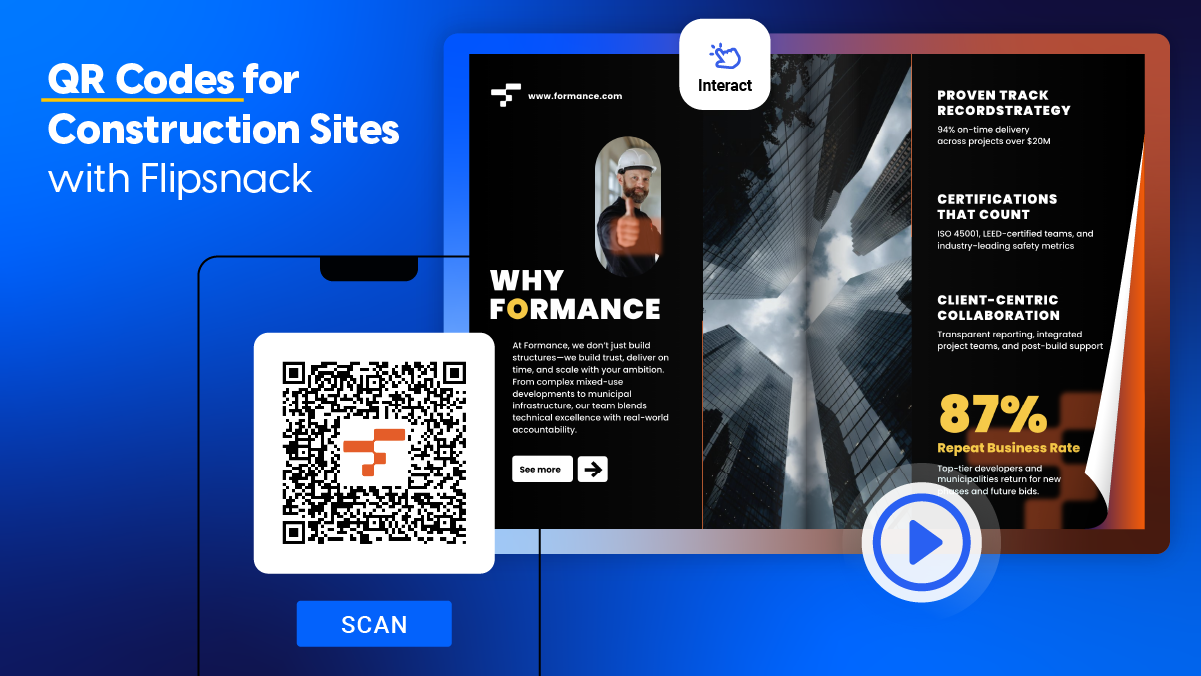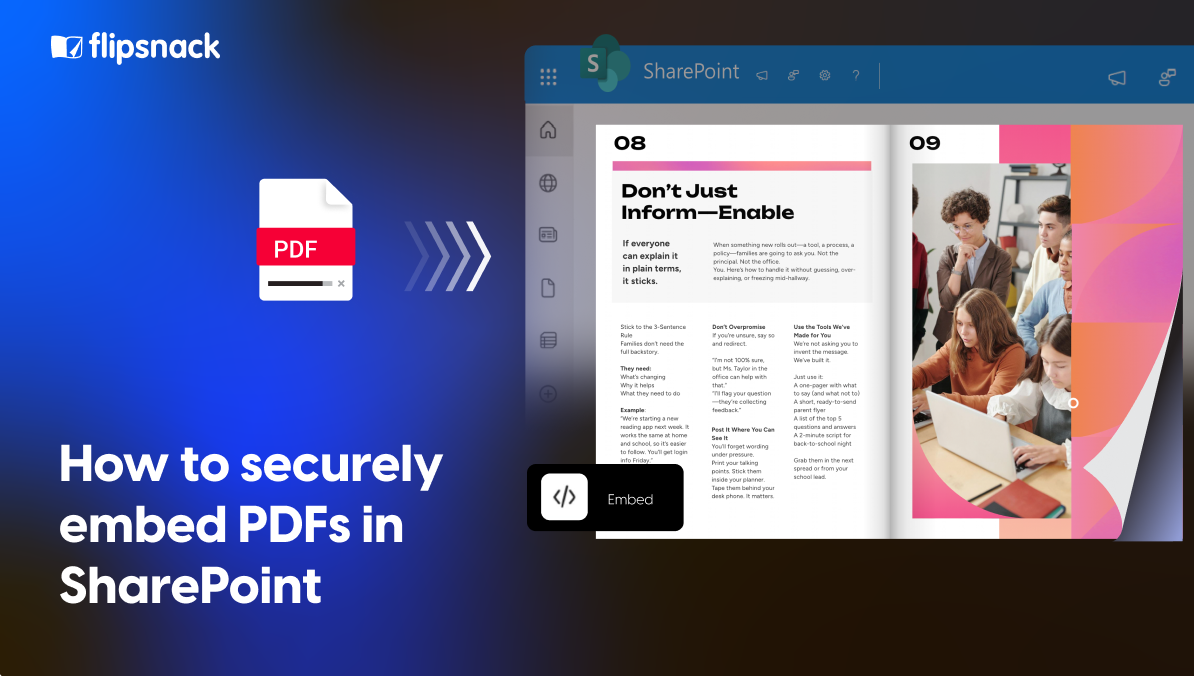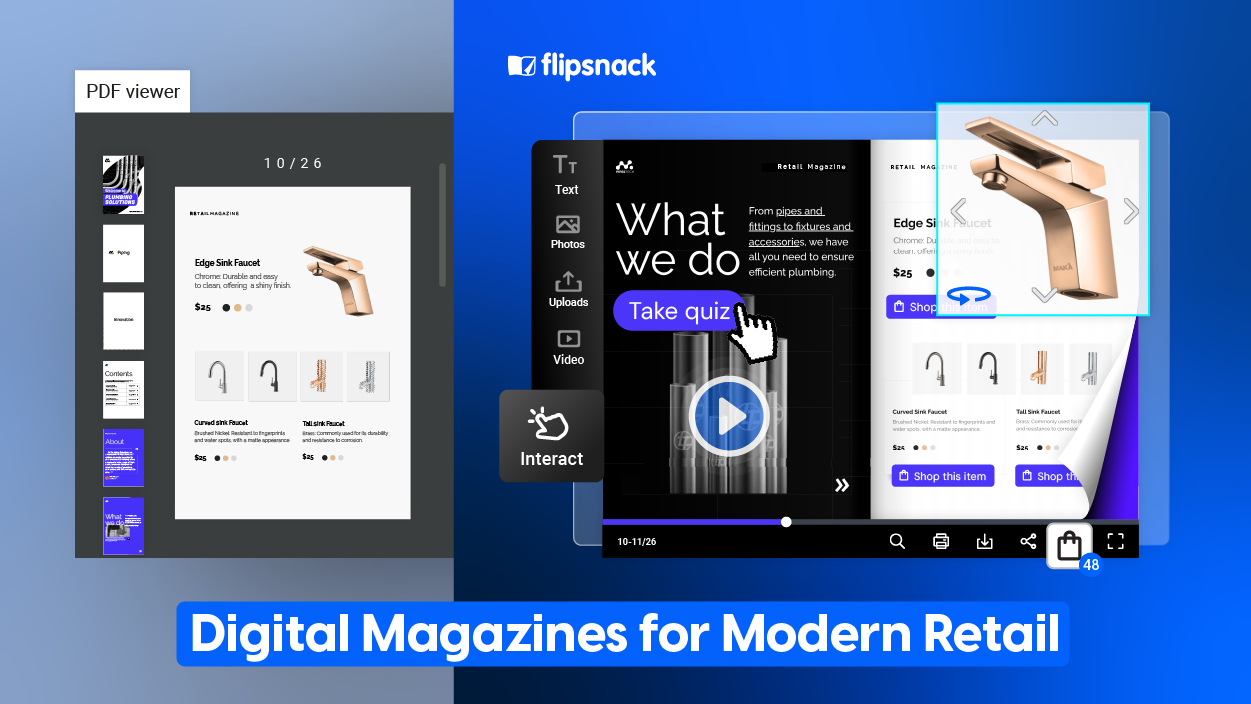QR Codes in Construction: 9 Ways to Improve Communication on Jobsite
We often think of QR codes for restaurant menus or event tickets, but their utility stretches far beyond these common applications.
Think about a bustling construction site, a hub of constant activity and change. How do you ensure everyone – from the experienced foreman to the curious local resident – has instant access to the most current details?
This is where a simple QR code for a construction site can prove to be extremely useful. They can link residents to construction site updates and workers to digital blueprints, track tools and equipment, verify safety compliance, streamline inspections, or control building access.
If the materials you link to are interactive, even better.
Flipsnack can help you from start to finish: easily create the interactive materials (digital flipbooks) you want to share and generate QR code construction sites.
So, let’s see what are the benefits of using QR codes in construction and how you can share your materials via QR code using Flipsnack.
But first let’s see how a flipbook for construction sites can look.
Think interactive elements like videos, site walkthroughs, and even client testimonials, all presented in a branded, professional format like this construction company profile flipbook:

Table of contents
Practical QR code applications on jobsites and buildings
1. Client and stakeholder updates
Keeping clients and investors informed is key to a project’s success. A QR code can be used on project reports or interactive presentations. Scanning the code directs them to a digital flipbook with high-resolution photos, drone footage of recent progress, and dynamic project timelines, providing an engaging and transparent way to share updates.
2. Blueprints and plans
Contractors are often stuck with outdated paper blueprints on-site. By placing a QR code on the physical drawings, a builder can scan it with their phone to instantly access the most current digital version.
This includes updates, design revisions, and interactive 3D BIM models, all housed within a digital flipbook. This ensures everyone is working from the same page, preventing costly errors and rework.
3. Training and onboarding
Onboarding new hires can be time-consuming. A QR code placed at a workstation or on a safety sign can serve as a powerful training tool. When scanned, it links directly to safety manuals or training guides with videos on tool usage, step-by-step assembly guides, and critical safety information. This allows new employees to learn at their own pace and get up to speed quickly and safely.
4. Tool and equipment management
Keeping track of every piece of equipment on a large jobsite is a major challenge. By attaching a QR code to each tool, a foreman or worker can scan it to access its complete history. This digital flipbook can include maintenance records, user manuals, and even check-in/check-out logs, reducing tool loss and ensuring equipment is always in good working order.
5. Safety and compliance verification
Maintaining a safe and compliant jobsite requires constant vigilance. A QR code for construction site safety can be placed at an entrance or specific hazard area. When scanned, it gives a worker or inspector immediate access to official safety certifications, recent inspection results, or a digital log of compliance checks, proving that all protocols are being followed and documented.
6. Inspections and quality control
Quality control inspections can be a slow, paper-heavy process. A QR code placed on a completed section of a building—like a finished wall or electrical panel—can be scanned to open a digital inspection form. Inspectors can then fill out the form on their mobile device, streamlining the entire reporting process and eliminating manual data entry. Beyond QR codes, many contractors standardize updates through field-service software platforms to streamline team communication, automate reporting, and improve overall jobsite visibility.
7. Waste and materials management
Tracking material deliveries and waste disposal is crucial for project budgeting and sustainability. By placing a QR code on a material pallet or a waste container, a worker can scan it to access a digital tracking log. They can record delivery dates, quantities, and even track waste streams, all of which can be used to generate detailed sustainability reports.
8. Emergency management and response
In an emergency, every second counts. Strategically placed QR codes for construction sites can be lifesavers. Scanning a code at a site entrance or a central hub can instantly display a digital emergency flipbook. This can include a clear evacuation map, a list of emergency contact numbers, and a simple, step-by-step guide on how to handle specific on-site emergencies.
9. Visitor and access control
Manage site access more securely and efficiently. Visitors, vendors, or new tenants can be issued a temporary QR code that they scan to enter a building or jobsite. This same code can link to a digital welcome guide or a self-guided tour of the property.

How to choose the right QR code tools and software
The power of a QR code for construction is in the data and functionality it unlocks. But this depends a lot on the platform you’re creating the materials you want to share through QR codes.
For B2B QR code applications in construction and property management, the free, static QR code generators simply won’t cut it. You need a robust platform with a suite of features designed for a dynamic, professional environment.
Here are the key features to look for when evaluating your options:
- Dynamic updates: The ability to change the content without having to generate and reprint a new QR code. This is the single most important feature for construction, where information is constantly changing.
- Detailed analytics: You need to know what’s working. The right platform will provide detailed statistics such as impressions and views, time spent on your flipbooks, time spent for each page individually, the number of downloads, and more.
- Brand customization: The QR code should reflect your company’s brand. Look for a platform that allows you to add your logo to the QR code so people can recognize it faster and make the connection that there is information about the construction site.
- Interactivity & rich media: The QR code should be a gateway to more than just a simple webpage or PDF. Link your QR code to a platform that allows you to create interactive digital content that helps people get the information in an engaging way.
- Privacy and security: For internal documents, training materials, or client reports, security and private sharing are very important. Look for features like password protection and unlisted sharing options to ensure sensitive information remains private.
Flipsnack vs. other platforms that generate QR codes
| Feature | Generic Free QR Code Generators | Specialized QR Code Platforms (e.g., Flowcode, QR Code Generator Pro) | Flipsnack |
| Primary Use | Simple links for personal or basic marketing use | B2C Marketing, brand promotion, and some basic asset tracking | Interactive digital publications and documents |
| Dynamic Updates | No (typically static) | Yes (most plans) | Yes |
| Analytics | No, or very limited scan count | Yes, with metrics like location and device | Yes, with detailed publication-level analytics and Google Analytics integration |
| Rich Media | Links to external video or image URLs | Links to simple landing pages with basic embeds | Full support for embedding videos, photo slideshows, audio, forms, and surveys directly within the flipbook |
| Document Security | Not available | Limited to password protection on some platforms | Yes, offers private sharing, password protection, SSO, and unlisted flipbooks |
| Core Value | Quick link creation | Branded, trackable link | A powerful platform for creating, managing, and sharing a library of branded, interactive digital documents |
| Ideal for… | A one-off link for a small event flyer | A branded QR code for a business card | Managing a library of blueprints, safety guides, training manuals, and project reports—all accessible via a simple QR code |
How to create and share construction sites materials with Flipsnack
Flipsnack’s intuitive Design Studio allows anyone, regardless of technical skill, to transform static files into interactive resources and then share them instantly via QR code.
Here’s a step-by-step guide to get you started:
Step 1: Upload your documents
Start with what you already have. Upload existing PDFs, images, or even entire folders of documents directly into Flipsnack. Your blueprints, safety manuals, inspection checklists, and project reports are instantly transformed into an engaging, page-flipping digital format.
Step 2: Add interactivity
Use the drag-and-drop editor to enrich your documents, turning them from static pages into interactive tools.
- Embed videos: For your training manuals, embed YouTube or Vimeo videos showing the proper way to use a tool or perform a safety check.
- Include forms: On a quality control checklist or inspection report, add a customizable form to collect data directly from the user’s mobile device. All collected data is stored in your Flipsnack account for easy review and download.
Link to other resources: Make your documents smarter by adding links. Link a specific section of a blueprint to a detailed specification sheet, or link a safety protocol to an emergency contact list. You can link to external websites or other pages within the same flipbook.
Step 3: Publish your interactive flipbook
You can choose to publish publicly, privately with a password, or as an “unlisted” document that is only accessible via its direct link. This level of control is essential for managing sensitive project information.
Step 4: Generate your QR Code
Every published flipbook automatically gets a URL that stays the same even after you update your flipbook.
- Navigate to your flipbook’s Details page.
- Select the “Download QR Code” tab.
- Brand it with your company’s logo.
- Download the QR code image.
Now, simply place this QR code anywhere on the jobsite. The code is dynamic, which means if you need to update the flipbook—say, a blueprint changes or a new safety video is released—the QR code you already printed will automatically direct users to the updated version. No need to reprint.
Benefits of QR codes in construction and building management
1. Time savings and efficiency
QR codes in construction cut out wasted time. Instead of digging through binders or chasing down colleagues for the latest plans, workers can scan a code and get what they need instantly. Updates happen in real time, so everyone stays aligned without delays.
2. Safety and compliance
QR codes in construction make it easy to access manuals, training materials, or inspection checklists on the spot. They also help verify certifications or compliance records, reducing the chance of errors or overlooked requirements.
3. Cost reductions
A QR code for construction site equipment can cut inspection time by minutes, and across dozens of inspections each week, those minutes add up to hours of paid labor saved. Codes on tools reduce losses and wasted time spent searching. Linking plans through a QR code helps avoid rework caused by outdated drawings, which can easily cost thousands when crews have to redo work. Even printing costs drop when codes connect workers to digital files instead of new paper sets.
4. Transparency for stakeholders
Clients, investors, and managers want visibility. A quick scan can link them to progress reports, photos, or dashboards. This level of openness builds trust and keeps everyone on the same page.

Manage construction site updates with QR codes
The construction industry is built on a foundation of tangible materials—steel, concrete, and timber. Yet, the most critical element driving success today is digital information. As we’ve seen in this article, a simple QR code can be the most efficient bridge between the physical world of the jobsite and the essential digital data that powers it.
By leveraging QR codes for construction sites for everything from blueprints and safety manuals to client updates and tool tracking, companies can cut costs, improve efficiency, and, most importantly, create a safer, more transparent environment for everyone involved.
With a platform like Flipsnack, you can stop managing a flood of paper and start creating a connected, intelligent information hub—one simple scan at a time.



